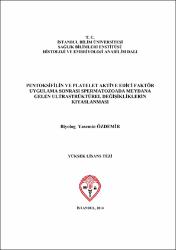Pentoksifilin ve platelet aktive edici faktör uygulama sonrası spermatozoada meydana gelen ultrastrüktürel değişikliklerin kıyaslanması
Künye
Özdemir, Yasemin. (2014). Pentoksifilin Ve Platelet Aktive Edici Faktör Uygulama Sonrası Spermatozoada Meydana Gelen Ultrastrüktürel Değişikliklerin Kıyaslanması. Yayımlanmamış yüksek lisans tezi. İstanbul : İstanbul Bilim Üniversitesi, Sağlık Bilimleri Enstitüsü.Özet
Günümüzde evli çiftlerde yaklaşık olarak % 10-15 oranında infertilite görülmekte olup etiyolojik nedenler göz önüne alındığında % 40-50 kadarında erkek faktörüne rastlanmaktadır. Erkeğe bağlı infertilite problemi, düşük sayıda spermatozoon üretimi, spermatozoon motilitesinde azalma veya spermatozoon morfolojisinin yetersiz oluşu gibi özelliklerin tek başına veya bir kaçının birlikte görüldüğü durumlarda ortaya çıkar.
İlk in vitro fertilizasyon (IVF) bebeğinin 1978’de doğumundan beri yardımla üreme teknikleri (YÜT)’nin uygulanma endikasyonları ve başarı oranları giderek artmıştır.
Tüp bebek uygulamalarında bilim adamlarının üzerinde durduğu yegane durumlardan biri döllenme oranını arttırabilmektir. Bu yüzden in vitro fertilizasyon (IVF) uygulamalarında canlı spermatozoon seçimi önemlidir. Bunun için birçok yöntem ve farklı ajanlar kullanılmaktadır. Bu ajanlar içinde yaygın kullanım alanı bulanlar pentoksifilin (PF) ve platelet aktive edici faktör (PAF)’dür.
Yapmış olduğumuz bu çalışma ile in vitro fertilizasyon (IVF) uygulamalarında kullanılan bu alternatif ajanların spermatozoon motilitesi ve ince yapısı üzerindeki etkilerini incelemeyi amaçladık.
Bu nedenle çalışmamızda normozoospermik semen örneklerinden elde edilen
spermatozoonlara pentoksifilin (PF) ve platelet aktive edici faktör (PAF) ile muamele edildi. Spermatozoonların membran yapısındaki glikokaliks, rutenyum red boyası ile belirginleştirilip örnekler geçirimli elektron mikroskobunda (TEM) kıyaslanarak incelendi. Ayrıca herhangi bir ajanla muamele olmamış kontrol grubu oluşturularak, pentoksifilin (PF) ve platelet aktive edici faktör (PAF) uygulanmış gruplarla karşılaştırıldı.
Sonuç olarak çalışmamızda spermatozoonların pentoksifilin (PF) ve platelet aktive edici faktör (PAF)’e maruz kalmasının spermatozoon baş ve kuyruk yapısındaki olumsuz etkileri gösterilmiştir. Ultrastructural Changes Occured In Spermatozoa After The Application of Pentoxifylline and Platelet-Activating Factor
Nowadays it is known that infertility affects 10-15 % of married couples. When etiologic factors are considered, male factor is responsible for about 40 % of the issues involved with infertility. Male infertility arise due to the low sperm count, decrease in the motility or poor morphology of the semen sample, alone or in combination of more than one of these factors.
Indications and success rates of assisted reproductive techniques (ART) has steadily increased since the birth of the first in vitro fertilization (IVF) baby in 1978. Since than, the most important issue emphasized by scientists was to increase the fertilization rate. That is why the selection of a viable spermatozoa is very important during in vitro fertilization (IVF) procedures. Different techniques and agents are used for this purpose. Of these agents the most commonly used ones are pentoxifylline (PF) and platelet-activating factors (PAF).
In this study we aimed to examine the effect of these alternative agents on sperm motility and fine morphology. The semen samples obtained from normozoospermic man were treated with PF and PAF. The glycocalyx, which is found in the structure of sperm membrane is marked by ruthenium red staining method and the ultrastructure of stained samples are examined by transmission electron microscopy (TEM). A control group was created with this samples and we also aimed to examine by considering sperm morphology without appliying any pentoxifylline (PF) and platelet-activating factor (PAF).
As a result, the application of pentoxifylline (PF) and platelet-activating factor (PAF) had a negative effect on the ultrastructure of the head and flagellum of the spermatozoa.


















